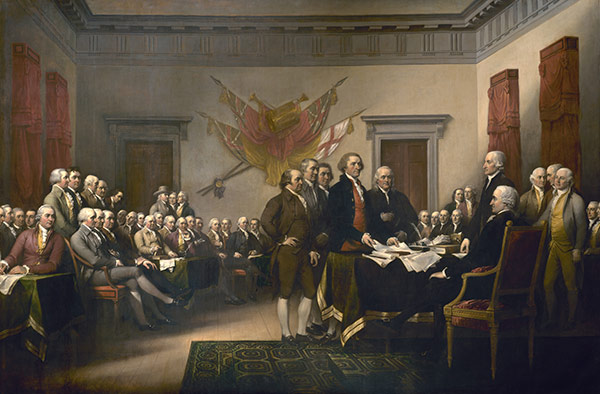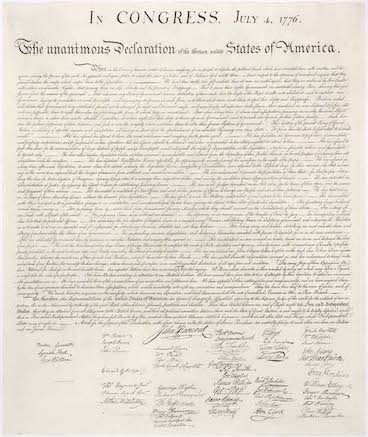
Courtesy: Architect of the Capitol.

Visitors to the National Archives on the Mall in Washington come to see the two founding documents of the United States of America, the Declaration of Independence and the Constitution. Few are aware that the manuscript they see of the Declaration (stone engraving shown above) is not the physical document handwritten by Thomas Jefferson and approved on July 4, 1776. The document under glass in the National Archives is a copy made in August 1776 and signed over the next six months by the delegates who approved it on July 4. The original document disappeared during the night of July 4 and has never been found.
I came upon the mystery in a somewhat roundabout way of how the original founding document of our country got lost. After learning about it, I decided to see if I could discover anything about the original that was not already known.
In June 1970 Professor Julian P. Boyd hired me as his summer research assistant. I was 17 and Mr. Boyd (he did not have a PhD) was the first editor of the Papers of Thomas Jefferson. He edited the papers (mostly from photostatic copies) for print publication in an office on the second floor of the Princeton University library. I had served as a library assistant the previous summer so I had some familiarity with library research.
I was hired back for three more summers and I stayed in touch with Professor Boyd afterward. Before he died in 1980, he gave me an article that he had written in 1976 titled "The Declaration of Independence: The Mystery of the Lost Original." A copy is here. [See Note 1 below for citation.]
The original Declaration was a manuscript having the final text as amended and approved by Congress on July 4, 1776. Jefferson was charged to have the document printed that night so that copies could be sent out by dispatch riders. He walked the manuscript a few blocks to the print shop of John Dunlap, whose assistants quickly began to typeset the document. Dunlap printed over 100 copies of which 26 (known as the Dunlap broadsides) are known to survive today.
Before he died, the U.S. Department of State asked Jefferson where the original was, and he was dismayed to learn that it wasn't in his own papers. A later search in the files of Congress and the State Department also turned up nothing, and it hasn't been found since then. The only image we have is by the painter John Trumbull, who depicted Jefferson holding it in a giant mural now standing in the Rotunda of the U.S. Capitol in Washington. Jefferson made a preliminary sketch of the scene himself that Trumbull turned into a painting (below).

Courtesy: Architect of the Capitol.
Adding to the mystery was a question by a historian, David F. Hawke, who asked Professor Boyd about a document held by the Pennsylvania Historical Society and known as the "proof copy" of the Declaration. The Dunlap printers typeset this copy, of which the first half survives, so that Jefferson could check it for errors. But there was something odd about the proof copy. The printers typeset a number of cryptic markings on it that they copied from the text of the original document. These consisted of vertical quotation marks in groups of one, two, three, and four scattered over letters, words, and spaces. Someone, probably Jefferson, ordered the removal of these in the version to be printed. Professor Boyd was asked about these markings.
The authenticity of the proof copy became clear in 1976 when at Professor Boyd's suggestion the Library of Congress recalled 17 of the 21 printed copies of the Declaration of Independence known to exist at the time. These copies received a forensic examination reported a year later in a review (scroll down to page 531). [See Note 2 below for citation.] The printed copies were compared with each other and with the proof copy.
Any sort of code embedded in the text of the original manuscript, now missing, was a cause for concern. Professor Boyd made a careful study of the rough drafts of the Declaration, though, and found similar markings on some of them. As he explained in the article that he gave me, the markings were clearly there to guide Jefferson in reading the document aloud to the assembled delegates in Philadelphia. The markings indicated where to pause for effect and where to lend ascending forms of emphasis. Jefferson was known to be a good writer but a bashful public speaker. He later explained what markings like these meant in an essay titled "Thoughts on English Prosody."
Professor Boyd also ventured an explanation of what happened to the original document. The 1976 examination revealed that the printed copies were printed in great haste. What probably happened was that the original four-page document was cut into four sections. Four teams of typesetters could then have worked simultaneously to set the type for printing. After copies of the Declaration were each printed and dispatched, the sections of the original were probably crumpled and defaced with ink and were best discarded. Not the most auspicious beginning for a new country but at least the Declaration got a head start that night.
For a long time I pondered what mystery could possibly remain about the original manuscript. No one had found it and its markings and subsequent loss had plausible explanations. But upon further reflection, it finally occurred to me that something else in the document had been hiding in plain sight all along. My mom trained as a classical pianist and regularly practiced from sheet music, much of it written two centuries ago. What Thomas Jefferson had done was leave an audio (speaking) version of the Declaration of Independence in the markings that survive on the proof copy.
Using his rules and marks for public speaking, it may be possible to deliver the Declaration in two voices, one speaking from the marked-up text of the proof copy as Jefferson might have delivered it, and another voice speaking from the other half of the printed version with no markings. A recording of the document might then be made, some two and one-half centuries after its first delivery.
Notes
1. Julian P. Boyd, "The Declaration of Independence: The Mystery of the Lost Original," Pennsylvania Magazine of History and Biography (October 1976), pp. 438-467.
2. C. William Miller, Review of Frederick R. Goff, The John Dunlap Broadside: The First Printing of the Declaration of Independence (Washington: Library of Congress, 1976) in the Pennsylvania Magazine of History and Biography (October 1977), pp. 531-533.